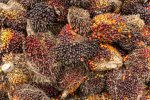
Rapeseed (canola) (Brassica napus) not only produces a highly valuable cooking oil but its protein content is also useful because of its rich amino-acid profile. It has been cultivated for over 4,000 years and is now a major oil-seed crop in most parts of the world.
Thirty million tons of rapeseed are produced annually, mainly for its oil but once expressed the residue contains about 40% to 45% protein. The crop is one of the largest in northern climate countries such as the UK, Canada and the USA. In Canada it accounts for 20% of global production (Azargohar et al., 2013).
A web-site, canolainfo.org markets the benefits of the oil and contains many useful news items on health benefits, recipes and ways of use.
It is also worth noting that canola oil is also extracted from other Brassica seed species such as B. rapa and B. juncea (Shahidi, 2005).
Nutritional Value Of Canola (Rapeseed) Oil
Rapeseed meal is a good protein source for animal feed—it has a high phytate content with a low phytase activity (EC 3.1.3.26), the activity of which is destroyed by heating in the preparation of the feed. Phytate is a useful source of phosphates but can block mineral absorption in the intestine.
There are two proteins in the seed, an albumin type called napin (1.7 S) and a globulin called cruciferin (12 S) which are now available commercially for the product developer. They form 20 and 60% respectively of the total protein in mature seeds and the total protein accounts for between 20 and 25% w/w of the dry seed content (Finlayson, 1976). Cruciferin is of considerably higher molecular weight than napin, being a neutral mix of many polypeptide chains (Schwenke et al., 1981). Napin on the other hand is a basic pH structure of two disulphide linked polypeptide chains (Crouch et al., 1983). Burcon NutraScience Corp. (Vancouver, BC. Canada) have extracted and separated the two proteins outlined earlier to form two isolates, Puratein™ (cruciferin-rich fragment) and Supertein™ (napin-rich fragment).
Canola/Rapeseed Oil
Canola/Rapeseed oil mainly consists triglycerides, together with minor compounds such as free phenolic acids. These acids include vanillic, ferulic, p‐coumaric, chlorogenic, caffeic, and so on, as well as a number of esterified phenolic acids, free fatty acids, proteins, etc, (Abuzaytoun & Shahidi, 2006; Alkan et al., 2011; Alam et al., 2016).
The phenolic content of rapeseed (canola) is very much higher than other oilseeds (Chen et al., 2014).
Rapeseed Oil And Diabetes
Rapeseed oil ingestion could have long-term benefits for those coping with diabetes. At the Scientific Sessions for the June 2014 mtg. of the American Diabetes Association, a presentation showed how a rapeseed oil-rich diet which also had a low glycaemic load, could lower blood glucose levels in type-2 diabetic patients, especially those with raised systolic blood pressure (CanolaInfo, 2014; Jenkins et al., 2014). In this randomised controlled study, the subjects, all with type-2 diabetes were taking drugs to control their glycaemia and were placed on either a rapeseed (canola) based diet or a healthy control variant. The rapeseed based diet had a low glycaemic index but was higher in fat than the control diet, and included bread containing rapeseed oil (31g oil per person per day). The control diet was a lower fat variant with high-fibre content highlighting the benefits of consuming whole wheat foods. The diets might contain varying amounts of different foodstuffs but it highlights an intriguing correlation between lipid intake and lowering blood glucose levels (glycaemic control) which deserves further investigation.
References
, , , & (2013). Slow pyrolysis of deoiled canola meal: Product yields and characterization. Energy & Fuels, 27, 5268–5279 (Article).
CanolaInfo. (2014) Canola oil helps control blood glucose in people with type 2 diabetes. Press Release, June 16.
Crouch, M. L., Tenbarge, K. M., Simon, A. E., Ferl, R. (1983) J. Mol. Appl. Genet. 2, pp. 273-283
, , , & (2014). Value‐added potential of expeller‐pressed canola oil refining: Characterization of sinapic acid derivatives and tocopherols from byproducts. Journal of Agricultural and Food Chemistry, 62(40), 9800–9807 (Article).
Finlayson, A. J. (1976) in: The Biology and Chemistry of the Cruciferae (Vaughan, J. G., McLeod, A. J., and Jones, B. M. G., eds) Academic Press, New York. USA pp. 279-306
Jenkins, D.J.A., Kendall, C.W.C., Vuksan, V., Faulkner, D., Augustin, L.S.A., Mitchell, S., Ireland, C., Srichaikul, K., Mirrahimi, A., Chiavaroli, L., Blanco Mejia, S., Nishi, S., Sahye-Pudaruth, S., Patel, D., Bashyam, B., Vidgen, E., de Souza, R.J., Sievenpiper, J.L., Coveney, J., Josse, R.G., and Leiter, L.A. (2014) Effect of lowering the glycemic load with canola oil on glycemic control and cardiovascular risk factors: a randomized controlled trial. Diabetes Care 37 pp. 1806-1814
Schwenke, K. D., Raab, B., Linow, K.-J., Patz, W., Uhlin, J. (1981) Die Nahrung 25, pp. 271-280
(2005). Bailey’s Industrial Oil and Fat Products, 1 New York: st. ed. Wiley.
1st revision 22nd September 2014.

Leave a Reply